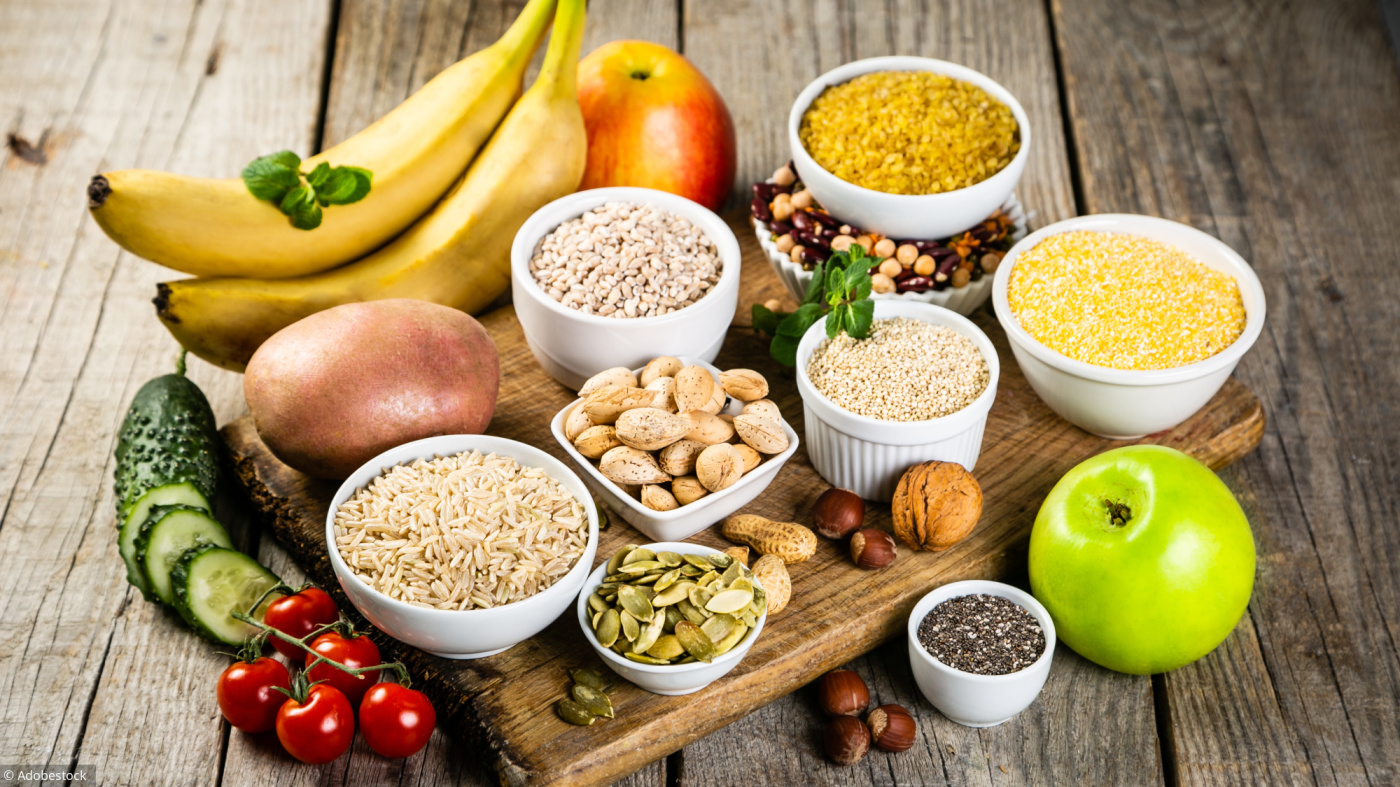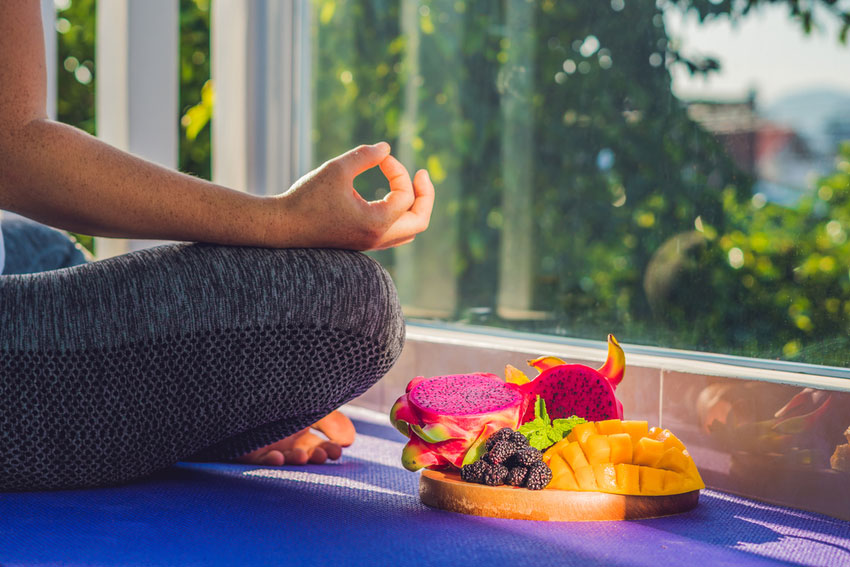Nutrition and yoga
It is an approach that is more and more known and recognized, the practice of yoga often goes hand in hand with a balanced lifestyle, which includes diet. A real driving force in our daily lives, food, through its mix of flavors, diversity or cooking methods, gives a different perspective to our regular practice of yoga, relaxation, or mindfulness. Practicing yoga is therefore a rich and complete sport!
According to a survey, two thirds of people say that a balanced diet is important, and 81% say they follow a balanced diet. A telling figure, which testifies to a desire to feel good outside as well as inside, which the practice of yoga would reinforce. Thus, whether it is kundalini, pranayama, nidra, ayurveda, prenatal yoga, stretching or meditation, everything is subject to feeling better while eating!
But then what are the most important pillars when we decide to eat according to our yoga practice? That's what we're going to see right now!
Why think about what we eat?
When practicing yoga, eating is as important as many things. We simply need to realize that we ingest food, and that it is essential for our body to function and improve our well-being. Yes, we are what we eat, as they say, and to do this, it is important to know how to think about our plate, balance flavors, nutrients and remove certain elements from our dishes.
Because yes, a healthy mind in a healthy body is not necessarily a cliché, and to think that the food we eat can transform us is often a proven fact. So, thinking, in full awareness, what we eat, knowing how to combine flavors and different textures, bringing to our body the right nutrients, without neglecting pleasure, here are some small ways to apprehend cooking and yoga. But, in reality, why think about all this? For many reasons:
• To adopt an ecological and more responsible approach,
• By conviction, like vegetarianism,
• To lose weight,
• To respect certain traditions or religions,
• To enjoy the benefits of sport to the fullest,
• To realize that you know how to take care of your body,
• To practice mindfulness,
Thus, it will have been understood, the culture of yoga inspires enormously, when it is a question of knowing how to eat, but especially of knowing how to eat "well". Because many are the pillars that make us realize that a plate is also and especially a contribution of nutrients, whether good or bad. It's up to us!

Mastering Balance in Yoga Nutrition
Just like in sports, yogic nutrition favors balance. But what is balance? It is simply the balance of flavors, which will also materialize at the gym or during group classes of kundalini yoga, stretching, or iyengar yoga. But not only that!
Indeed, when preparing a dish for oneself or for others, it is important, by following this pillar, to know how to associate tastes, of course, but also textures, colors, and nutrients to bring to our body. What a way to feel better just by looking at your plate!
The balance also lies in the way you eat. It is essential not to restrict oneself too much or not to stuff oneself at certain times, but to be as regular as possible in its caloric and nutritional intake. A bit like mastering balance in yoga! In the long run, we should not try to be as efficient as possible, to bring a minimum of ingredients or a maximum of calories to our body.
Thus, our well-being capital will find itself favored, by this temperance and this vision of life which, without a doubt, will make us aware that eating is also an art, and almost a sport! Between sun salutation, breathing exercises, and vital energy, welcome to yogic nutrition!
To know how to use mindfulness in yogic nutrition
It's a fact, most of the time we are not sufficiently aware of what we ingest and what we put in our dishes. A bunch of coriander, a few pieces of grated ginger, garlic, everything has a taste, everything goes together, and you have to know how to make it. A bit like when we practice yoga postures, the important thing is to know how to coordinate ourselves and become aware of our body.
Here, the principle is the same, and we don't have aches and pains the next day, the main thing is to know what we are going to put in our mouth and, more generally, in our body, in order to make it last a whole day. In this perspective, it is therefore also important to note what we eat, when we eat it. At such and such a time, I eat more meat than usual, why, how, do I want to do something about it, etc?
Each change and each meal brings with it its share of small questions, observations to make, and awareness to conduct, at their scale of course. This nourishment of the mental body is a real driving force. It is a motor of form, a motor of health, but also more globally a motor of life. Because for many people, what we eat is constitutive of our mental health, in addition to forging our physical health, which yoga implies.
Yoga is a complete discipline, which makes the whole body work, so it is important that the pillars of nutrition that are linked to it fit well. This is of course the case of mindfulness, which will give food a much more spiritual perspective, in addition to the nutritional vision. Children's yoga, traditional yoga, raja yoga, yoga sutra, everything is good for eating well!

Yoga and food
In this perspective of mindfulness, yoga also develops a small technique, according to which one would eat in silence. Called "Muna", and characteristic of mental food, this way of seeing things is similar to a much more first-degree view of food, almost as if it were sacred.
Indeed, in order to stabilize the mind, to harmonize and to be more in adequacy with oneself, one will thus advocate to become aware of food in a religious silence, which will also allow us to be alone with ourselves. A way of concentrating not on what the food will produce in the future, but on what it produces at the very moment when we eat it, when we ingest it.
Yoga is also about letting go of one's movements, about ultimate concentration on what one is doing, and only looking at the movements one is doing, a bit like a bubble in the end.
Choosing the right foods when doing yoga
This silence is often associated with carefully chosen and consumed products. For example, a yogic food will be quite loaded with "prana" (food of vital energy), and local products will be the typical example. On the other hand, one can also choose the rawest possible foods, in order to better appreciate their true taste.
In addition to this precise choice of ingredients, chewing them is an important point when it comes to linking yoga to the act of eating. For yes, what better way to become aware of the foods we have chosen than to chew them well. Repetition creates the awareness that eating is not only bringing one's body to life, but also participating in the life of one's mind.
It is also important, like the Okinawa diet, to moderate your food intake, to nuance your meals in terms of quantity, to the privilege of quality. Yogic food is based on the principle that eating is a real act, almost a step, and overloading your plates would be counterproductive. We must therefore give our bodies time to assimilate everything they have just ingested, whether it be nutrients, flavors or quantities.
Finally, let's also think about taking inspiration from vegetarian cuisine which, by definition, advocates non-violence (animal), and therefore non suffering in itself. An approach and a way of thinking that can be interesting, and favour the positions of all those who wish to eat well, also from an ethical point of view. Yes, yoga is a rich discipline, which also combines a real perspective of awareness, and vegetarianism can testify to this.
So yoga seems to be a real driving force in knowing how to eat. If yogic food does not exist in itself, it has the merit of having created a real approach, which advocates food as a motor, and food as an act in itself. It is an act that we think about, which suggests that everything, from yoga postures to stretching, through a series of exercises, goes through our plate.
Food and yoga: eating according to the seasons
According to Ayurveda, the medicine attached to the practice of yoga, each yogi must follow the cycle of the seasons when it comes to diet. One must then adapt to the fruits and vegetables given by nature in order to eat properly. The diet therefore varies throughout the year and it is unthinkable to eat the same thing in January and August. This seasonal routine is called Ritoucharya.
Following this tradition, yogis choose to follow the three Ayurvedic seasons. These correspond to the three doshas. To help you to concoct your small dishes, here are some indications:
The Vata season: from mid-October to mid-March. This period corresponds roughly to winter and must therefore consist of warm dishes such as soups, a great favorite dish of yogis in winter).
Kapha season: from mid-March to mid-June. In spring, the diet is lighter and the dishes contain much less fat. We prepare baked dishes in particular.
Pitta season: from mid-June to mid-October. In summer, you can eat fresh fruit and other foods that can be eaten raw.
Eating according to the seasons is also a way to respect nature, an important precept for most yogis. Not using products or other techniques to grow fruits and vegetables that would not otherwise grow is the best way to eat healthy and environmentally friendly.
This way of choosing food also allows you to choose foods rich in "prana". For yogis, food transmits energy when ingested. This is why it is preferable to choose local and naturally produced foods so as not to ingest food with bad energy (such as animal suffering for meat).
What are the foods recommended by yoga?
While doing yoga, some people decide to follow the rules of the Ayurvedic tradition to the letter. In this tradition, there are three qualities of food. This is the theory of gounas.
The foods can then be sattviques, rajasic or tamasic. They are classified according to their effects on the mental, physical and virtues they possess.
Sattvic foods are neutral, light and balancing foods. In this category we can count vegetables and fruits in general, clarified butter, legumes (lentils for example) as well as whole grains.
Tamasic foods are negative foods, rather heavy or with bad ethics. This is particularly the case with meat, onions or garlic. They are therefore foods to be avoided in meals.
Finally, Râjasic foods are energy-giving foods and are rather positive. This can be coffee, chilli, salt or other.

To accompany these three food categories, another classification has arrived, that of the six flavors. Also established by Ayurveda, this classification helps to balance meals. The flavors are called the six Rasas. Each dish must contain a little of each of these six flavors:
• Sour food : Lemon, yoghurt, vinaigrette sauce, etc.
• Sour food: It must be integrated in small quantities. It can be endives for example.
• Spicy food: Red pepper, pepper, fresh ginger, spices must be used in the right dosage so as not to ingest too much.
• Rough food: Green vegetables in general (spinach, cabbage, broccoli, etc.), beans and legumes in general.
• Salty food: Use the natural salt of the food or add a pinch of salt.
• Sweet food: Cooking naturally sweet foods such as fruit or sweet foods such as rice or sweet potatoes. Added sugar should of course be avoided as much as possible.
Yoga and Cooking: Eating at the right temperature
You will have understood it, to follow a food based on the ayurvedic tradition is to find the good balance in its plate. This balance must also be found in the temperature of the food you eat. Although it is sometimes tempting, it is better to avoid eating too hot or too cold.
Ice cream is therefore not very recommended, even though it is of course possible to crack from time to time. Just as soups that are too hot should be cooled before eating. Just wait a few minutes for a good moderate temperature to set in.
Eating too hot or too cold can be bad for the stomach and therefore for your health in general.
But in Asian medicine, eating too hot or too cold also refers to food. A hot food can for example be chilli pepper. By eating this type of food, the body warms up and even sweats.
Cold vegetables, on the other hand, are more like water vegetables or fruits such as watermelon, cucumber, seaweed, red fruits, etc.
Once again, it is a matter of finding the right balance to avoid stomach aches, diarrhea, etc.
Knowing food incompatibilities to eat like a yogi
To avoid bloating, a yogi must respect and be aware of food incompatibilities. Indeed, some foods should not be eaten at the same time, at the risk of having some digestion problems.
For example, milk or honey should be eaten away from meals so as not to coat the food and thus slow down digestion. This is for example the case with milk cereals in the morning. This habit makes digestion difficult because the cereals are then compacted and stuck with the milk.
Fruits should also be given special attention. They are digested much faster than the rest of the food. By eating them at the end of the meal, these fruits will be stored while waiting for the rest to be digested. It is therefore preferable to keep the fruit as a snack for example.
Also be careful not to eat too much starchy food all at once or to mix cooked and raw foods in the same dish.

Take the time to leave vacuum in the stomach
Ayurvedic medicine is clear: to eat well you must listen to yourself. Each person does not have the same needs in terms of food and does not always have the same hunger as his neighbor. However, in our society, we always tend to fill our plates well until you're full.
However, this practice is far from being the best for our body according to the Asian tradition. According to nutrition specialists, if we feel stiff and heavy at the end of a meal, it is because we have eaten too much and digestion will be difficult.
It is thus necessary to learn to proportion its plate according to its appetite and do not forget to leave vacuum in the stomach from time to time. This allows it to breathe and regenerate. A stomach that is always active will be sick more often.
So no more snacking between meals or at any time. The best is to have a full meal at lunchtime, to give the stomach time to digest all this, and to take a lighter meal in the evening.
Fasting is also highly recommended to let your body breathe. The stomach thus has plenty of time to digest properly. It can therefore be a partial fast from 10am to 2pm every day. You can thus consider leaving the evening meal or breakfast aside. Of course, fasting can be risky, and it is best to follow it with a nutrition specialist.
It is also highly recommended to leave two hours between a meal and a yoga class so as not to upset your stomach by bending it during asanas.
Yoga Culture : Moisturize well when you eat
To do yoga or simply for your daily health, drinking water is important. But beware! It is not a question of drinking three liters during a meal! Drinking too much water while eating makes your stomach heavier. The best is to plan an infusion at the end of the meal.
Drinking tea before a yoga session is also a very good idea to gain flexibility and succeed in all the positions of the yoga class as it should be.
Hydration is important for the body in order to circulate blood more easily. But the body also needs water to renew itself. Water is indeed a very important component of our body.
Conclusion
This is why, in terms of diet, the Ayurvedic tradition encourages each yogi to choose these foods in full consciousness according to his personal convictions and needs in order to best manage the body's balance.
Therefore, there is not only one way of doing so, but as many ways of eating as there are people. It is necessary beforehand to be in agreement with oneself while paying attention of course to one's health.


